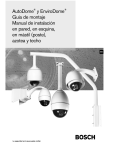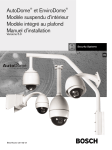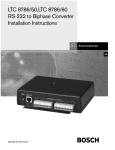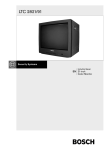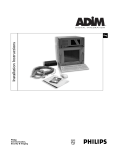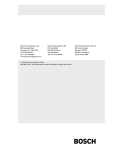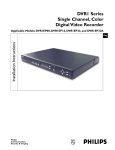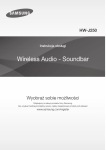Download Bosch LTC 7490 Operating instructions
Transcript
LTC 7490/20C AutoDome Series Ceiling Mount Backbox Modules Installation Instructions EN Security you can rely on EN Important Safeguards 1. Read and Retain Instructions - All safety and operating instructions should be read before the unit is operated. Follow all operating and use instructions. 2. Heed Warnings - Adhere to all warnings on the unit and in the operating instructions. 3. Attachments - Attachments not recommended by the product manufacturer should not be used, as they may cause hazards. 4. Accessories - Do not place this unit on an unstable stand, tripod, bracket, or mount. The unit may fall, causing serious injury to a person and serious damage to the unit. Use only with a stand, tripod, bracket, or mount recommended by the manufacturer or sold with the product. Any mounting of the unit should follow the manufacturer's instructions and should use a mounting accessory recommended by the manufacturer. An appliance and cart combination should be moved with care. Quick stops, excessive force, and uneven surfaces may cause the appliance and cart combination to overturn. 5. Power Sources - This unit should be operated only from the type of power source indicated on the label. If unsure of the type of power supply to use, consult your dealer or local power company. For units intended to operate from battery power or other sources, refer to the operating instructions. This equipment is to be isolated from the mains supply by a limited power source as specified in EN60950. The ENVPSU or ENV-PA1 are examples of such power sources. 6. Power Lines - An outdoor system should not be located in the vicinity of overhead power lines or other electric light or power circuits or where it can fall into such power lines or circuits. When installing an outdoor system, extreme care should be taken to keep from touching such power lines or circuits as contact with them might be fatal. U.S.A. models only - refer to the National Electrical Code Article 820 regarding installation of CATV systems. 7. Servicing - Do not attempt to service this unit yourself as opening or removing covers may expose you to dangerous voltage or other hazards. Refer all servicing to qualified service personnel. 8. Replacement Parts - When replacement parts are required, be sure the service technician has used replacement parts specified by the manufacturer or have the same characteristics as the original part. Unauthorized substitutions may result in fire, electric shock, or other hazards. 9. Safety Check - Upon completion of any service or repairs to this unit, ask the service technician to perform safety checks to determine that the unit is in proper operating condition. © 2003 Bosch Security Systems Important Safeguards 10. Coax Grounding - If an outside cable system is connected to the unit, be sure the cable system is grounded. U.S.A. models only--Section 810 of the National Electrical Code, ANSI/NFPA No.70-1981, provides information with respect to proper grounding of the mount and supporting structure, grounding of the coax to a discharge unit, size of grounding conductors, location of discharge unit, connection to grounding electrodes, and requirements for the grounding electrode. FCC & ICES Information (U.S.A. and Canadian Models Only) WARNING - This equipment has been tested and found to comply with the requirements for a Class A digital device, pursuant to Part 15 of the FCC Rules and ICES-003 of Industry Canada. These limits are designed to provide reasonable protection against harmful interference when the equipment is operated in a residential installation. This equipment generates, uses, and radiates radio frequency energy and, if not installed and used in accordance with the instructions, may cause harmful interference to radio communications. Operation of this equipment in a residential area is likely to cause harmful interference, in which case the user will be required to correct the interference at his own expense. Intentional or unintentional changes or modifications not expressly approved by the party responsible for compliance shall not be made. Any such changes or modifications could void the user’s authority to operate the equipment. If necessary, the user should consult the dealer or an experienced radio/television technician for corrective action. The following booklet prepared by the Federal Communications Commission may be helpful: How to Identify and Resolve Radio-TV Interference Problems. This booklet is available from the U.S. Government Printing Office, Washington, DC 20402, Stock No.004-000-00345-4. WARNING: THIS IS A CLASS A PRODUCT. IN A DOMESTIC ENVIRONMENT, THIS PRODUCT MAY CAUSE RADIO INTERFERENCE, IN WHICH CASE THE USER MAY BE REQUIRED TO TAKE ADEQUATE MEASURES. Page 2 of 16 EN Safety Precautions CAUTION: TO REDUCE THE RISK OF ELECTRICAL SHOCK, DO NOT OPEN COVERS. NO USER SERVICEABLE PARTS INSIDE. REFER SERVICING TO QUALIFIED SERVICE PERSONNEL. The lightning flash with an arrowhead symbol within an equilateral triangle is intended to alert the user to the presence of uninsulated "dangerous voltage" within the product's enclosure that may be of sufficient magnitude to constitute a risk of electric shock to persons. The exclamation point within an equilateral triangle is intended to alert the user to presence of important operating and maintenance (servicing) instructions in the literature accompanying the appliance. WARNING: TO PREVENT FIRE OR SHOCK HAZARD, DO NOT EXPOSE UNITS NOT SPECIFICALLY DESIGNED FOR OUTDOOR USE TO RAIN OR MOISTURE. Attention: Installation should be performed by qualified service personnel only in accordance with the National Electrical Code or applicable local codes. Power Disconnect. Units with or without ON-OFF switches have power supplied to the unit whenever the power cord is inserted into the power source; however, the unit is operational only when the ON-OFF switch is in the ON position. The power cord is the main power disconnect for all units. Cover Removal WARNING: REMOVAL OF THE COVER SHOULD ONLY BE PERFORMED BY QUALIFIED SERVICE PERSONNEL NOT USER SERVICEABLE. THE UNIT SHOULD ALWAYS BE UNPLUGGED BEFORE REMOVING THE COVER AND REMAIN UNPLUGGED WHILE THE IS REMOVED. 24 VAC Units: Do not exceed 30 VAC input. Voltage applied to the unit's power input should not exceed 30 VAC. Normal input voltage is 24 VAC. User supplied wiring from 24 VAC supply to unit must be in compliance with electrical codes (Class 2 power levels). Do not ground 24 VAC supply at power supply terminals or at unit's power supply terminals. This equipment is to be isolated from the mains supply by a limited power source as specified in EN60950. The ENV-PSU or ENV-PA1 are examples of such power sources. 220-240 V, 50 Hz Power Cords 220-240 V, 50 Hz power cords, input and output, must comply with the latest versions of IEC Publication 227 or IEC Publication 245. © 2003 Bosch Security Systems Safety Precautions Sécurité ATTENTION : POUR ÉVITER TOUT RISQUE D’ÉLECTROCUTION, NE PAS OUVRIR LE BOÎTIER. IL N’Y A PAS DE PIÈCES REMPLAÇABLES À L’INTÉRIEUR. POUR TOUTE INTERVENTION, S’ADRESSER À UN RÉPARATEUR PROFESSIONNEL COMPÉTENT. L’éclair fléché dans un triangle équilatéral avertit l’utilisateur de la présence d’une « tension dangereuse » non isolée à l’intérieur de l’appareil et d’une valeur suffisante pour constituer un risque d’électrocution. Le point d’exclamation contenu dans un triangle équilatéral avertit l’utilisateur de la présence, dans la documentation qui accompagne l’appareil, d’importantes consignes d’utilisation et de maintenance. AVERTISSEMENT : POUR ÉVITER LE RISQUE D’ÉLECTROCUTION OU D’INCENDIE, NE PAS EXPOSER À LA PLUIE OU À L’HUMIDITÉ UN APPAREIL NON CONÇU POUR UNE UTILISATION EXTÉRIEURE. Attention : L’installation doit être exclusivement effectuée par un technicien spécialisé conformément à la réglementation du code national de l’électricité des États-Unis (NEC) ou à la réglementation locale. Coupure de l’alimentation. Les appareils avec ou sans commutateur ON-OFF (marche-arrêt) sont alimentés dès que le cordon d’alimentation est branché à la source d’alimentation ; toutefois, les appareils disposant d’un commutateur de marchearrêt ne fonctionnent que lorsque celui-ci est sur la position ON (marche). Le cordon d’alimentation est l’organe de coupure principal de l’alimentation pour tous les appareils. Enlèvement du capot AVERTISSEMENT : L’ENLÈVEMENT DU CAPOT NE DOIT ÊTRE EFFECTUÉ QUE PAR UN TECHNICIEN SPÉCIALISÉ. IL N’Y A PAS DE PIÈCES REMPLAÇABLES OU RÉGLABLES PAR L’UTILISATEUR. IL FAUT TOUJOURS DÉBRANCHER L’APPAREIL AVANT D’ENLEVER LE CAPOT ET LE LAISSER DÉBRANCHÉ JUSQU’À LA REMISE EN PLACE DU CAPOT. Appareils 24 VCA: Ne pas excéder 30 V c.a. La tension appliquée à l’entrée d’alimentation de l’appareil ne doit pas excéder 30 V c.a. La valeur normale de la tension d’entrée est 24 V c.a. Le circuit électrique reliant l’alimentation 24 V c.a. à l’appareil doit être conforme aux codes électriques (niveaux d’alimentation de classe 2). Ne pas mettre l’alimentation 24 V c.a. à la masse au niveau des bornes de l’alimentation ou de l’appareil. Cet équipement doit être isolé de l’alimentation secteur par une source de puissance limitée, conformément à la norme EN60950. Les appareils ENV-PSU et ENV-PA1 sont des exemples de telles sources d’alimentation. Cordons d’alimentation 220-240 V, 50 Hz Les cordons d’alimentation 220-240 V, 50 Hz, d’entrée ou de sortie, doivent être conformes à la dernière version de la publication IEC 227 ou IEC 245. Page 3 of 16 EN Vorsichtsmaßregeln VORSICHT: DAS GEHÄUSE ZUR VERMEIDUNG VON ELEKTRISCHEN SCHLÄGEN NICHT ÖFFNEN. DAS GERÄT ENTHÄLT KEINE VOM BENUTZER ZU WARTENDEN TEILE. REPARATUREN NUR VON FACHPERSONAL AUSFÜHREN LASSEN. Safety Precautions Precauciones de seguridad PRECAUCIÓN: PARA REDUCIR EL RIESGO DE DESCARGAS ELÉCTRICAS, NO ABRA LAS TAPAS. EN EL INTERIOR NO HAY NINGÚN COMPONENTE REPARABLE POR EL USUARIO. LAS REPARACIONES DEBEN SER REALIZADAS POR PERSONAL CUALIFICADO. Das Blitzsymbol in einem Dreieck soll den Benutzer auf nicht isolierte „gefährliche Spannung“ im Produkt hinweisen, die ausreichend hoch ist, um eine Gefahr von elektrischen Schlägen für Menschen darzustellen. El símbolo de flecha en forma de rayo situado dentro de un triángulo equilátero pretende alertar al usuario de la presencia de un “voltaje peligroso” sin aislamiento dentro de la caja del producto, que podría alcanzar una magnitud suficiente para presentar un riesgo de descarga eléctrica a personas. Das Ausrufezeichen in einem Dreieck soll den Benutzer auf wichtige Bedienungs - und Wartungsanweisungen in der dem Gerät beiliegenden Dokumentation hinweisen. El punto de exclamación dentro de un triángulo equilátero pretende alertar al usuario de la existencia de instrucciones de funcionamiento y mantenimiento (reparación) en la documentación suministrada con el aparato. WARNUNG: ZUR VERMEIDUNG VON FEUER UND ELEKTRISCHEN SCHLÄGEN DARF DAS GERÄT WEDER REGEN NOCH FEUCHTIGKEIT AUSGESETZT WERDEN, ES SEI DENN, ES IST AUSDRÜCKLICH FÜR DEN EINSATZ IM FREIEN AUSGELEGT. Achtung: Die Installation darf nur von qualifiziertem Wartungspersonal gemäß dem National Electrical Code oder den gültigen örtlichen Vorschriften durchgeführt werden. Abtrennen des Netzkabels: Die Spannungsversorgung zu Geräten mit und ohne Ein/Aus-Schalter ist dann hergestellt, wenn das Netzkabel an eine Netzsteckdose angeschlossen ist. Das Gerät ist jedoch nur betriebsbereit, wenn der Ein/AusSchalter eingeschaltet ist. Bei allen Geräten erfolgt das Abtrennen vom Netzstrom durch Abziehen des Netzkabels. Abnehmen des Gehäuses WARNUNG: DAS GEHÄUSE DARF NUR VON QUALIFIZIERTEM WARTUNGSPERSONAL ABGENOMMEN WERDEN – REPARATUREN DURCH DEN BENUTZER SIND NICHT MÖGLICH. VOR DEM ABNEHMEN DES GEHÄUSES MUSS STETS DER STECKER AUS DER NETZSTECKDOSE GEZOGEN WERDEN UND BEI ABGENOMMENEM GEHÄUSE ABGEZOGEN BLEIBEN. Geräte für 24 V Wechselstrom: 30 V Wechselstrom nicht überschreiten. Die Spannung, die dem Stromanschluss des Geräts zugeführt wird, darf 30 V Wechselstrom nicht überschreiten. Die normale Eingangsspannung beträgt 24 V Wechselstrom. Die vom Benutzer vorzusehende Verkabelung von einer 24-V-Wechselstromquelle zum Gerät muss den elektrischen Vorschriften (Stromstärke der Klasse 2) entsprechen. Die 24-VWechselstromversorgung nicht an den Stromversorgungsklemmen der Stromquelle oder des Geräts erden. Dieses Gerät muss durch ein Netzteil nach den LimitedPower-Source-Vorschriften EN60950: von der Netzstromversorgung isoliert sein. ENV-PSU und ENV-PA1 sind Beispiele für derartige Netzteile. Netzkabel für 220–240 V/50 Hz Netzkabel für 220–240 V/50 Hz, Eingang und Ausgang, müssen den neuesten Versionen der IEC Publikation 227 oder IEC Publikation 245 entsprechen. © 2003 Bosch Security Systems AVISO: PARA IMPEDIR EL RIESGO DE INCENDIO O DESCARGA, NO EXPONGA A LLUVIA O HUMEDAD LAS UNIDADES QUE NO SE HAYAN DISEÑADO ESPECÍFICAMENTE PARA USO EN EXTERIORES. Atención: la instalación debe realizarla personal cualificado en cumplimiento estricto del código eléctrico nacional (en el caso de los EE.UU.) o de los códigos locales aplicables. Desconexión eléctrica. Tanto las unidades provistas de interruptor de encendido como las unidades sin él, comienzan a recibir corriente eléctrica cuando se enchufa el cable de alimentación en la fuente de alimentación; no obstante, la unidad sólo entra en servicio cuando el interruptor de encendido se coloca en la posición ON. El cable de alimentación es el medio principal para desconectar la corriente de todas las unidades. Retirada de la cubierta AVISO: LA RETIRADA DE LA CUBIERTA SÓLO DEBE SER REALIZADA POR PERSONAL DE SERVICIO CUALIFICADO. LA UNIDAD NO CONTIENE PIEZAS QUE PUEDA REPARAR EL USUARIO. LA UNIDAD DEBE SER DESENCHUFADA DE LA RED SIEMPRE ANTES DE RETIRAR LA CUBIERTA Y PERMANECER DESCONECTADA HASTA QUE ÉSTA VUELVA A COLOCARSE . Unidades de 24 V CA: La corriente de entrada nunca debe sobrepasar 30 V CA. La tensión aplicada a la entrada de la unidad no debe exceder de 30 V CA. La tensión de entrada normal es de 24 V CA. El cableado suministrado por el usuario desde la fuente de alimentación de 24 V CA hasta la unidad debe cumplir las normativas eléctricas pertinentes (niveles de potencia de Clase 2). No conectar a tierra la corriente de 24 V CA en los terminales de la fuente de alimentación ni en los terminales de alimentación de la unidad. Este equipo debe estar aislado de la red eléctrica por medio de una fuente de alimentación limitada, según se especifica en EN60950. Las unidades ENV-PSU o ENV-PA1 son ejemplos de fuentes de alimentación de esta clase. Cables de alimentación de 220-240 V, 50 Hz Los cables de alimentación de 220-240 V, 50 Hz, tanto en la entrada como en la salida, deben cumplir las versiones más modernas de las publicaciones IEC 227 o 245. Page 4 of 16 EN Veiligheidsmaatregelen VOORZICHTIG: MAAK HET APPARAAT NIET OPEN OM DE KANS OP ELEKTRISCHE SCHOKKEN TE VERMIJDEN. BEVAT GEEN ONDERDELEN DIE DE GEBRUIKER MOET ONDERHOUDEN. LAAT REPARATIES EN ONDERHOUD OVER AAN EEN DESKUNDIGE SERVICETECHNICUS. Het symbool ‘Bliksemflits met pijlkop’ in een gelijkzijdige driehoek wijst de gebruiker op de aanwezigheid in de behuizing van het apparaat van niet geïsoleerde gevaarlijke spanningen die voldoende sterk zijn om het risico van elektrische schokken op te leveren. Het uitroepteken in een gelijkzijdige driehoek wijst de gebruiker op belangrijke aanwijzingen voor bediening en onderhoud in de bij het apparaat geleverde documentatie. WAARSCHUWING: TER VOORKOMING VAN BRANDGEVAAR EN ELEKTRISCHE SCHOKKEN MOGEN APPARATEN DIE NIET SPECIFIEK VOOR GEBRUIK IN DE OPEN LUCHT ZIJN ONTWORPEN NIET AAN REGEN EN VOCHT WORDEN BLOOTGESTELD. Let op: Het apparaat mag uitsluitend door bevoegd technisch personeel worden geïnstalleerd en wel in overeenstemming met de National Electrical Code of de daarvoor plaatselijk geldende richtlijnen. Stroomonderbreking. Apparaten met of zonder AAN-UIT schakelaars staan onder spanning op het ogenblik dat de voedingskabel in de voedingsbron wordt bevestigd; dergelijke apparaten zijn echter alleen bedrijfsklaar als de AAN-UIT schakelaar in de stand AAN is geschakeld. De netvoedingskabel is de hoofdstroomonderbreker voor alle aangesloten apparaten. Behuizing verwijderen WAARSCHUWING: DE BEHUIZING MAG UITSLUITEND DOOR DESKUNDIG TECHNISCH PERSONEEL WORDEN VERWIJDERD – REPARATIE DOOR DE GEBRUIKER IS NIET MOGELIJK. DE NETVOEDING VAN HET APPARAAT MOET ALTIJD WORDEN ONTKOPPELD VOORDAT DE BEHUIZING WORDT VERWIJDERD EN DIENT ONTKOPPELD TE BLIJVEN ZOLANG DE BEHUIZING NIET OPNIEUW IS AANGEBRACHT. Apparaten voor 24 V wisselstroom Sluit geen hogere spanning aan dan 30 V wisselspanning. De spanning die op de voedingsingang van het apparaat wordt aangesloten, mag nooit hoger zijn dan 30 V wisselspanning. De normale ingangsspanning is 24 V wisselspanning. De door de gebruiker toegepaste verbindingskabel tussen een voedingsbron met 24 V wisselspanning en het apparaat moet voldoen aan de plaatselijk geldende voorschriften voor elektrische bedrading (Spanningsniveaus Klasse 2). De 24 V wisselstroomvoeding mag niet op het lichtnet (stopcontact) of de netaansluiting van het apparaat worden geaard. Deze apparatuur moet van het elektriciteitsnet worden geïsoleerd door een stroombegrenzing zoals gespecificeerd in EN60950. Voorbeelden van dergelijke voedingsbronnen zijn apparaten van het type ENV-PSU en ENV-PAI. Netvoedingskabels 220-240 V, 50 Hz Netvoedingskabels 220-240 V, 50 Hz, voor ingangs- en uitgangsspanning, moeten voldoen aan de voorschriften in de meest recente uitgave van IEC publicatie 227 of IEC publicatie 245. © 2003 Bosch Security Systems Safety Precautions Precauzioni ATTENZIONE – PER RIDURRE IL PERICOLO DI SCOSSA ELETTRICA, NON APRIRE LE COPERTURE. L’INTERNO NON CONTIENE COMPONENTI CHE L’UTENTE PUÒ RIPARARE PERSONALMENTE. RIVOLGERSI AL PERSONALE DI ASSISTENZA QUALIFICATO PER QUALSIASI INTERVENTO DI RIPARAZIONE. Il simbolo di un fulmine con la punta a freccia racchiuso in un triangolo equilatero intende mettere in allerta l’utente riguardo alla presenza di tensioni pericolose non isolate all’interno del guscio dell’unità, che potrebbero essere di intensità sufficiente per costituire pericolo di elettrocuzione. Il punto esclamativo racchiuso in un triangolo equilatero intende avvisare l’utente in merito alla presenza di importanti istruzioni operative e di manutenzione nella documentazione di accompagnamento all’unità. AVVERTENZA – PER IMPEDIRE INCENDI O SCOSSA ELETTRICA, NON ESPORRE ALLA PIOGGIA O ALL’UMIDITÀ LE UNITÀ NON INTESE PER L’USO ALL’APERTO. Attenzione – Affidare l’installazione al solo personale qualificato e nel rispetto del codice elettrico nazionale (USA) o dei codici locali pertinenti. Distacco dalla rete elettrica. Le unità dotate o meno di un interruttore generale sono sempre sotto tensione quando il cavo di alimentazione è inserito nella fonte di corrente; tuttavia l’unità potrà funzionare soltanto se l’interruttore generale è in posizione ON (acceso). Disinserire il cavo di alimentazione è l’unico modo per scollegare completamente la corrente per tutte le unità. Rimozione della copertura AVVERTENZA – LA RIMOZIONE DELLA COPERTURA È DI COMPETENZA ESCLUSIVA DEL PERSONALE QUALIFICATO. ACCERTARSI CHE L’UNITÀ SIA SEMPRE SCOLLEGATA DALL’ALIMENTAZIONE ELETTRICA PRIMA DI TOGLIERE LA COPERTURA E NON RICOLLEGARLA SENZA RICHIUDERE TALE COPERTURA. Unità a 24 V CA Non superare la potenza di ingresso di 30 V CA. La tensione erogata all’ingresso di alimentazione dell’unità non deve superare i 30 V CA. La tensione d’ingresso normale è di 24 V CA. Un’unità alimentata con corrente da 24 V CA deve essere conforme alle normative elettriche stabilite in materia di livelli di potenza dalla Classe 2. Non fornire la messa a terra ad un alimentatore da 24 V CA tramite i terminali di alimentazione o i terminali di erogazione della corrente elettrica all’unità. Quest’apparecchiatura deve essere isolata dalla rete elettrica mediante l’uso di un alimentatore a corrente limitata, secondo le specifiche esposte in EN60950. I modelli ENV-PSU ed ENV-PA1 sono solo alcuni esempi di questi alimentatori. Cavi di alimentazione a 220-240 V, 50 Hz I cavi di alimentazione a 220-240 V, 50 Hz devono essere conformi (ingresso e uscita) alle versioni più recenti della pubblicazione IEC 227 o IEC 245. Page 5 of 16 EN Precauções de segurança CUIDADO: PARA REDUZIR O RISCO DE CHOQUE ELÉCTRICO, NÃO ABRA AS TAMPAS. NO INTERIOR NÃO SE ENCONTRAM PEÇAS CUJA MANUTENÇÃO POSSA SER REALIZADA PELO UTILIZADOR. A MANUTENÇÃO DEVE SER EFECTUADA POR PESSOAL QUALIFICADO. O símbolo do raio com a cabeça de uma seta dentro de um triângulo equilátero serve para alertar o utilizador para a presença de “tensões perigosas” não isoladas no interior da caixa do produto, as quais podem ser suficientemente elevadas para constituírem um risco de choque eléctrico. O ponto de exclamação dentro de um triângulo equilátero serve para alertar o utilizador para a existência de instruções importantes de operação e manutenção (assistência) na documentação fornecida junto com o aparelho. Safety Precautions Zasady bezpieczeństwa UWAGA: ZE WZGLĘDU NA NIEBEZPIECZEŃSTWO PORAŻENIA PRĄDEM NIE WOLNO OTWIERAĆ POKRYWY. W ŚRODKU NIE MA ŻADNYCH ELEMENTÓW, KTÓRE MOGĄ BYĆ NAPRAWIANE PRZEZ UŻYTKOWNIKA. NAPRAWĘ NALEŻY POWIERZYĆ AUTORYZOWANEMU PUNKTOWI SERWISOWEMU. Błyskawica ze strzałką wewnątrz trójkąta równobocznego ma za zadanie zwrócić uwagę użytkownika na obecność nieizolowanego “niebezpiecznego napięcia” wewnątrz obudowy urządzenia, o wielkości stwarzającej niebezpieczeństwo porażenia prądem. Wykrzyknik wewnątrz trójkąta równobocznego ma za zadanie zwrócić uwagę użytkownika na ważne czynności, związane z obsługą i konserwacją urządzenia, zamieszczone w Instrukcji obsługi. AVISO: PARA EVITAR O RISCO DE INCÊNDIO OU DE CHOQUE ELÉCTRICO, NÃO EXPONHA À CHUVA OU À HUMIDADE AS UNIDADES QUE NÃO TENHAM SIDO ESPECIFICAMENTE CONCEBIDAS PARA UTILIZAÇÃO NO EXTERIOR. OSTRZEŻENIE: ABY UNIKNĄĆ POŻARU LUB PORAŻENIA PRĄDEM NIE WOLNO WYSTAWIAĆ NA DZIAŁANIE DESZCZU LUB WILGOCI URZĄDZEŃ, KTÓRE NIE ZOSTAŁY ZAPROJEKTOWANE DO UŻYWANIA SPECJALNIE NA OTWARTYM POWIETRZU. Atenção: A instalação deve ser realizada por pessoal de manutenção qualificado, em conformidade com o National Electrical Code (Regulamento de Electricidade Nacional) ou outros regulamentos locais. Uwaga: Instalację urządzenia powinien wykonać tylko wykwalifikowany personel, zgodnie z przepisami NEC lub odpowiednimi przepisami miejscowymi. Corte da corrente. As unidades com interruptores ON-OFF [ligar/desligar] são alimentadas sempre que o cabo de alimentação estiver ligado à corrente. No entanto, a unidade só fica operacional quando o interruptor ON-OFF está na posição ON [ligado]. O cabo de alimentação é o principal meio de desligar qualquer uma das unidades da corrente. Remoção da tampa AVISO: A REMOÇÃO DA TAMPA DEVE SER EXCLUSIVAMENTE REALIZADA POR PESSOAL DE MANUTENÇÃO QUALIFICADO, NÃO CONSTITUINDO UM ELEMENTO CUJA MANUTENÇÃO POSSA SER FEITA PELO UTILIZADOR. A UNIDADE DEVE SER SEMPRE DESLIGADA DA CORRENTE, ANTES DA TAMPA SER REMOVIDA E PERMANECER DESLIGADA DA CORRENTE ENQUANTO AQUELA NÃO FOR COLOCADA. Unidades de 24 VAC: Não exceda 30 VAC à entrada. A tensão aplicada à entrada da unidade não deve exceder 30 VAC. A tensão nominal à entrada é de 24 VAC. Os cabos de 24 VAC de alimentação da unidade, fornecidos pelo utilizador, têm de estar em conformidade com os regulamentos eléctricos (níveis de potência da classe 2). Não ligue a alimentação de 24 VAC à terra mediante os bornes de alimentação ou os bornes de alimentação da unidade. Este equipamento deve ser isolado da rede de alimentação através de uma fonte de potência limitada, conforme especificado da norma EN60950. Constituem exemplos destas fontes de alimentação a ENV-PSU ou ENV-PA1. Cabos de alimentação de 220-240 V, 50 Hz Os cabos de alimentação de 220-240 V, 50 Hz, de entrada e saída, têm de estar em conformidade com as versões mais recentes da publicação CEI 227 ou publicação CEI 245. © 2003 Bosch Security Systems Odłączanie zasilania. Urządzenia zarówno nie posiadające, jak i posiadające wyłączniki WŁ-WYŁ znajdują się pod napięciem, jeżeli tylko przewód zasilający jest połączony ze źródłem zasilania. Jednakże urządzenie działa tylko wtedy, gdy wyłącznik znajduje się w położeniu WŁ. Przewód zasilający jest głównym odłącznikiem zasilania dla wszystkich rodzajów urządzeń. Zdejmowanie pokrywy OSTRZEŻENIE: POKRYWĘ URZĄDZENIA WINIEN ZDEJMOWAĀ TYLKO WYKWALIFIKOWANY PERSONEL SERWISOWY. PRZED ZDJĘCIEM POKRYWY NALEŻY ZAWSZE WYŁĄCZYĀ URZĄDZENIE Z SIECI. W CZASIE KIEDY POKRYWA JEST ZDJĘTA URZĄDZENIA NIE WOLNO ZAŁĄCZAĀ DO SIECI Zasilanie 24 V: Nie przekraczać napięcia wejściowego 30 V. Napięcie podawane na wejście zasilania urządzenia nie powinno przekroczyć 30 V. Znamionowe napięcia zasilania wynosi 24 V. Doprowadzenie napięcia zasilania 24 V należy przeprowadzić zgodnie z obowiązującymi przepisami (poziom zasilania klasy 2). Nie uziemiać napięcia zasilania na zaciskach zasilacza sieciowego lub urządzenia. To urządzenie winno być odizolowane od głównej sieci zasilającej za pomocą źródła zasilania o ograniczonej mocy, zgodnie z EN60950. Przykładami takich zasilaczy mogą być ENV-PSU lub ENV-PA1. Kable zasilające 220 –240 V, 50Hz Kable zasilające 220-240 V, 50 Hz, oraz wejścia i wyjścia muszą być zgodne z ostatnimi wersjami Publikacji 227 lub 245 IEC. Page 6 of 16 EN Introduction Table of Contents 1 UNPACKING 1 Unpack carefully. This is electromechanical equipment and should be handled carefully. 2 3 4 5 UNPACKING . . . . . . . . . . . . . . . . . . . . . . . . . . . . . . . . . . .7 1.1 Backbox Module . . . . . . . . . . . . . . . . . . . . . . . . . . . .7 SERVICE . . . . . . . . . . . . . . . . . . . . . . . . . . . . . . . . . . . . . . .7 DIMENSIONS . . . . . . . . . . . . . . . . . . . . . . . . . . . . . . . . . .7 INSTALLATION . . . . . . . . . . . . . . . . . . . . . . . . . . . . . . . . .8 4.1 Environmental Air Space Information . . . . . . . . . .8 4.2 Backbox Module . . . . . . . . . . . . . . . . . . . . . . . . . . . .8 4.3 Ceiling Mounting . . . . . . . . . . . . . . . . . . . . . . . . . . . .8 4.3.1 Backbox Module Mounting in Suspended Ceiling . . . . . . . . . . . . . . . . . . . . . . . .8 4.4 Address Switch Settings . . . . . . . . . . . . . . . . . . . . . . .9 4.5 Backbox Module Mounting . . . . . . . . . . . . . . . . . . .9 4.6 Installing the Backbox . . . . . . . . . . . . . . . . . . . . . . .10 4.7 Connecting Power, Signal, and Video . . . . . . . . . .10 4.7.1 Connecting Line Power . . . . . . . . . . . . . . . . . . .11 4.7.2 Connecting Biphase Signal Code . . . . . . . . . . .11 4.7.3 Connecting the AutoTracker (optional) . . . . . .12 4.7.4 Connecting the RS-232 / RS-485 Signal Cable . . . . . . . . . . . . . . . . . . . . . . . . . . . .12 4.7.5 Connecting the Video Cable . . . . . . . . . . . . . . .12 4.7.6 Connecting the Alarms and Relay Output . . . .12 MAINTENANCE/COMPONENT REPLACEMENT . . . . . . . . . . . . . . . . . . . . . . . . . . . . . . .13 Verify that the following items are included: • LTC 7490/20C unit: Backbox Base Bracket Assembly Trim Ring If an item appears to have been damaged in shipment, replace it properly in its carton and notify the shipper. If any items are missing, notify your Bosch Security Systems, Inc. Sales Representative or Customer Service Representative. The shipping carton is the safest container in which the unit may be transported. Save it for possible future use. 1.1 Backbox Module The LTC 7490/20C Backbox Module houses the Camera Module, and includes a bracket assembly for mounting onto a ceiling tile, trim rings for attractive appearance, and an isolated power supply. Model No. LTC 7490/20C 2 Rated Voltage 24 VAC 50/60 Hz Voltage Range 21 to 30 Power at Rated Voltage 15 W SERVICE If the unit ever needs repair service, the customer should contact the nearest Bosch Security Systems, Inc. Service Center for authorization to return and shipping instructions. Service Centers U.S.A.: Phone: 800-366-2283 or 408-956-3895 fax: 800-366-1329 or 408-956-3896 e-mail: [email protected] Canada: 514-738-2434 Europe, Middle East & Asia Pacific Region: 32-1-440-0711 For additional information, see www.boschsecuritysystems.com. 3 DIMENSIONS 175.9 Ø 6.93 mm in 164.1 6.46 15.2 0.60 87.5 3.45 159.3 Ø 6.27 188.5 Ø 7.42 Figure 1: Dimensional Outline (Camera Module Assembled in Backbox) © 2003 Bosch Security Systems Page 7 of 16 EN 4 Installation INSTALLATION Attention: Installation should be performed by qualified service personnel only, in accordance with the National Electrical Code or applicable local codes. 4.1 Ceiling Tile Suspension Bars Environmental Air Space Information Ceiling Base Bracket The AutoDome system is suitable for use in environmental air spaces or in an air handling plenum of a non-fire resistant ceiling. 4.2 Backbox Module The module consists of a Backbox and a Base Bracket Assembly (FIGURE 2). Wiring is via one entry hole located in the side of the backbox. If the conduit is not used, a strain relief bushing is required, in accordance with the National Electrical Code or applicable local codes. Figure 3 Ceiling Mounting (Top View) 2. Snap the bar clips over the ceiling rails (FIGURE 4). Slide the base plate to the desired position on top of the tile. x4 Figure 2 AutoDome Assembly 4.3 Ceiling Mounting 4.3.1 BACKBOX MODULE MOUNTING IN SUSPENDED CEILING Figure 4 Bracket Clip Fitting 3. Tighten the four (4) bracket screws located in each corner (FIGURE 5). Mount the backbox in a suspended ceiling grid using the existing ceiling tile as follows. 1. Locate the bracket assembly in the desired location (FIGURE 3). Loosen the securing screws (see FIGURE 5) on the base bracket assembly enough to retain the suspension bars during handling, but allowing for adjustment during installation. x4 Figure 5 Bracket Securing Screws © 2003 Bosch Security Systems Page 8 of 16 EN Installation 4. Cut a hole in the tile using the bracket as a template (FIGURE 6). The following dip switch settings pertain to AutoDome Versions 5.00 and newer. Switch # Function **1 Figure 6 Cutting the Tile Boot Mode Baud Rate (Firmware download only) Position Selection ON OFF 19.2K 57.6K* 2 Serial Mode Selection ON OFF RS-485 RS-232* 3 Camera Mode Selection ON OFF Boot Loader Mode Normal Mode* 4 Low Pressure Detection ON OFF Pressurized Dome Non-Pressurized Dome* *Default position for all switch settings is OFF. **Switch 1 Baud Rate only applies to a special mode to download new firmware. 5. Secure the bracket assembly to an overhead securing point using a safety cable (FIGURE 7). S105 Dip Switch Address Switch Figure 8 S105 Dip Switch and Address Switch Figure 7 Safety Cable Fitment 4.5 Backbox Module Mounting Mount the backbox into the installed bracket assembly as follows. 4.4 Address and Dip Switch Settings Before installing the backbox, set the Address and S105 switches (FIGURE 8). Setting the Address switch to 0000 (NOT RECOMMENDED) responds to all messages regardless of address; otherwise, the unit will only respond to commands issued for that address. 1. Verify that the edge of the hole will support the unit. If the edge is uneven or slightly too large, attach the appropriately colored (white/black) mounting ring, as shown in FIGURE 9 and FIGURE 10. If the backbox fits correctly, go directly to SECTION 4.6. Figure 9 Mounting Ring Fitment © 2003 Bosch Security Systems Page 9 of 16 EN Installation 2. Push the optional ring over the mounting box clips (FIGURE 10). Figure 10 Securing the Mounting Ring 4.6 Installing the Backbox 1. Push the backbox up through the hole in the ceiling until the two flexible clamps snap through the opening (FIGURE 11). 3. Tighten the two (2) flexible clamp screws. DO NOT OVER-TIGHTEN (FIGURE 13). Figure 13 Securing the Backbox 4.7 Connecting Power, Signal, and Video CAUTION: Before proceeding, disconnect the power from the cable to be installed into the unit. Be sure that the unit is of the proper line voltage type 24 VAC for line power being used. 1. Route the wires through the backbox connector opening (FIGURE 14 and FIGURE 15). Figure 11 Installing the Backbox 2. Push the backbox into the hole until completely flush (FIGURE 12). Figure 12 Installed Backbox © 2003 Bosch Security Systems Figure 14 Wire Installation Figure 15: Conduit Fitting or Strain Relief Bushing Page 10 of 16 EN Installation 2. Make the applicable wiring connections in accordance with the Connecting Line Power, Connecting Biphase Signal Cable, Connecting RS-232 / RS-485 Signal Cable, Connecting Video Cable, Connecting AutoTracker, Connecting Alarm Sections (FIGURE 16 through FIGURE 19). Wiring Guide* 24 VAC, 20 VA Max Wire Size mm2 AWG 1 18 1.5 16 2.5 14 28 VAC, 20 VA Max Wire Size mm2 AWG 1 18 1.5 16 2.5 14 Maximum Distance m ft 70 225 100 350 175 570 Maximum Distance m ft 270 750 370 1300 585 1900 *If connected to an AutoTracker, the camera must be within 15 meters (50 feet) of the AutoTracker. Figure 16 Connector Installation 4.7.2 CONNECTING BIPHASE SIGNAL CODE 1. If the camera is being connected to an AutoTracker, go to SECTION 4.7.3. 4.7.1 CONNECTING LINE POWER (see WIRING GUIDE in this section) 2. Unplug the connector (FIGURE 18) from the backbox. Make the power line connections to the power connector as follows: Biphase* 1. Unplug the connector (FIGURE 17) from the backbox. RS-232/RS-485** Figure 17 Power Connector Figure 18 Biphase / RS-232 / RS-485 Connector 2. Connect the neutral wire to the NEUT terminal, and the line wire to the LINE terminal using a flat-blade screwdriver. N/C is not used. 3. Identify the (+) phase, (–) phase, and GND wires. Use only twisted, shielded pair, Belden 8760 or equivalent. 3. When power is applied, a red LED will light. 4. Connect the plus phase to the + terminal, the minus phase to the – terminal, and the shielding ground of the cable to the *GND terminal using a flat-blade screwdriver. NOTES: *1. **2. © 2003 Bosch Security Systems The biphase shield should be grounded at one end only. The rcommended connection is at the signal source. If the internal switch position #2 is set to ON for RS-485 operation, then RXD functions as DATA (+) and TXD functions as DATA (–). Page 11 of 16 EN Installation 5. Route and connect the biphase connector as shown in FIGURE 19. Video Connector Alarm Connector NOTES: 1. The shield of the cable should be left unconnected. 2. If the internal switch #2 position is turned ON for RS-485 operation, RXD functions as DATA (+), and TXD functions as DATA (–). 4. Route and connect the RS-232 / RS-485 connector as shown in FIGURE 19. 4.7.5 CONNECTING VIDEO CABLE Route and connect the video cable to the BNC connector (FIGURE 19). 4.7.6 P102 Biphase / RS-232 / RS-485 P101 Power Connector Figure 19 Wire Routing & Connection 6. DAISY CHAIN Wiring: Connect the (+) of each of the cables by inserting them both into the (+) terminal on the terminal block. Connect the (–) of each of the cables by inserting them both into the (–) terminal on the terminal block. Connect the GND of each of the cables in a similar manner. A 110 OHM RESISTOR MUST BE CONNECTED BETWEEN THE BIPHASE (+) AND (–) TERMINALS ON THE LAST CAMERA. NOTE: Cameras connected to an AutoTracker cannot be used in a daisy chain. 4.7.3 CONNECTING THE AutoTracker (Optional) If the camera will be used with the Optional stand-alone AutoTracker, connect the Power, Video, and Biphase data to the AutoTracker first. Then connect the RS-232, Power, and Video outputs of the AutoTracker to the camera. (Refer to the AutoTracker INSTRUCTION BOOK for more details.) 4.7.4 CONNECTING THE RS-232 / RS-485 SIGNAL CABLE Not applicable if data input is via biphase codes (see SECTION 4.7.2) or if connected to an AutoTracker. CONNECTING THE ALARM INPUTS AND RELAY OUTPUT If the Alarm Inputs or the Relay Output are being used, connect them per FIGURE 20. 1. The Alarm Inputs must be connected to a dry contact. To activate an Alarm Input, the dry contact must change state between the appropriate Alarm Input and the Alarm Ground, Pin #8. For example, to activate Alarm Input #1, the dry contact must change state between Pins 7 & 8. 2. Alarm Relay Output Specification: 30VAC at 2 Amps; 60 Watts MAX. ALARM CONNECTOR 7 6 5 4 GND A1 8 A2 A3 A4 ALARM GROUND ALARM INPUT #1 ALARM INPUT #2 ALARM INPUT #3 3 2 1 NC COM NO RETAINING SCREW NORMALLY OPEN RELAY COMMON NORMALLY CLOSED ALARM INPUT #4 Figure 20 Alarm Connector NOTE: Push all excess cable through the conduit fitting or strain relief bushing. This will ensure that excess wire in the backbox will not interfere with the proper insertion of the camera module. 1. Unplug the connector (FIGURE 18) from the backbox. 2. Identify the RxD phase, TxD phase, and signal GND wires. 3. Connect the RxD phase to the RXD terminal, the TxD phase to the TXD terminal, and the signal ground to GND terminal marked GND using a flat-blade screwdriver (see NOTES). © 2003 Bosch Security Systems Page 12 of 16 EN 5 Maintenance/Component Replacement MAINTENANCE/COMPONENT REPLACEMENT No special maintenance is required. Occasionally dust may accumulate inside the housing and coat the transparent dome/trim ring. In this case, power the unit off and remove the dome so that it is away from the camera. While using proper eye protection, clean the dome by using clean compressed air from a spray can, and microwave safe paper towels, and reseat the dome. CAUTION: Do not remove camera from pan/tilt. Remove the entire receiver/driver, pan/tilt, and camera assembly from the AutoDome system to prevent damage to the flexible cable and connector. © 2003 Bosch Security Systems Page 13 of 16 EN © 2003 Bosch Security Systems Page 14 of 16 EN © 2003 Bosch Security Systems Page 15 of 16 Bosch Security Systems, Inc. 850 Greenfield Road Lancaster, PA 17601 U.S.A. Tel: 800-326-3270 Fax: 1-717-735-6560 Bosch Security Systems B.V. P.O. Box 80002, 5600 JB Eindhoven The Netherlands Tel: 31 40 278 1222 Fax: 31 40 278 6668 Bosch Singapore Pte. Ltd. 620A, Lorong I Toa Payoh Singapore 319762 Republic of Singapore Tel: 65 350 1859 Fax: 65 356 9202 Printed in USA 3935 890 11713 03-12 March 21, 2003 Security you can rely on

















